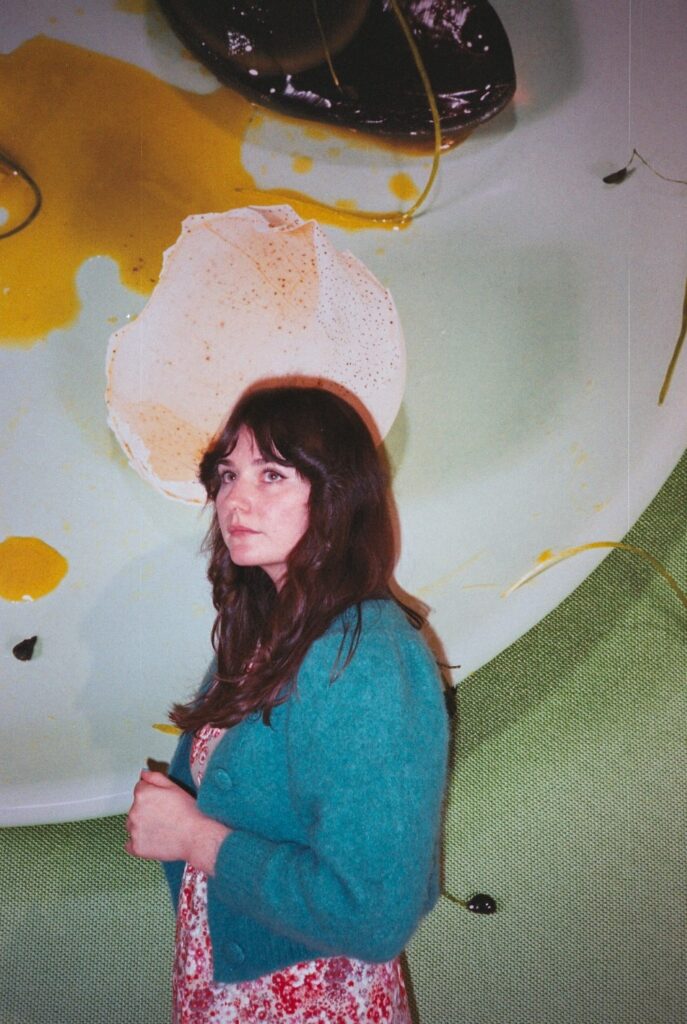
London-based photographer,
MAISIE COUSINS
Much like the work she creates, Maisie Cousins is colorful, alluring and maybe even a little playfully depraved at times. She has this delicate and reserved way about her, but there’s this underlying perversion that draws you in like she’s letting you in on a secret. Intense and subversive, Cousins’s pieces buzz with a shimmering overindulgence, mystifying viewers with one snap of a camera.
“Her stimulating images explore the relationship between the beautiful and the grotesque with a visceral rawness,” reads the press release. “Cousins uses intimately cropped images of detailed subject matter pushing the boundaries of seduction and repulsion. The glossy and hyper-saturated images display subject matter such as food, flowers, waste and the impoliteness of the body, the latter as celebration of femininity.”
Shelley Holcomb caught up with Cousins on her visit to Mexico City for the opening of her first solo show in Latin America to chat about the generation of her photography practice, her source material, and what it’s like to be addicted to chaos.
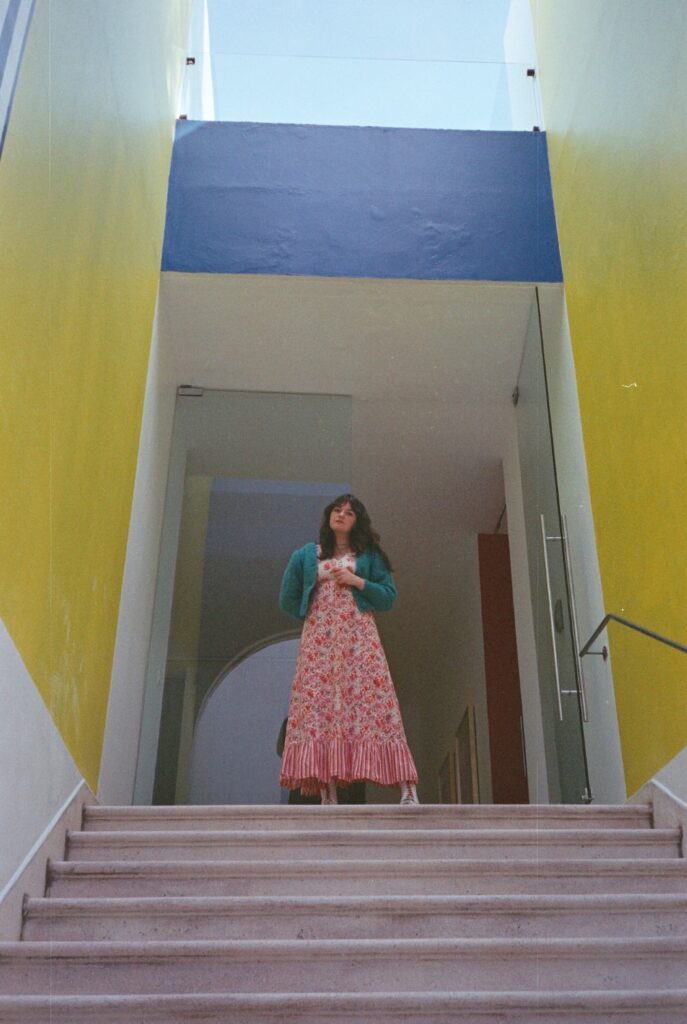
Portrait of Maisie Cousins 2021. © Courtesy of Galería Hilario Galguera.
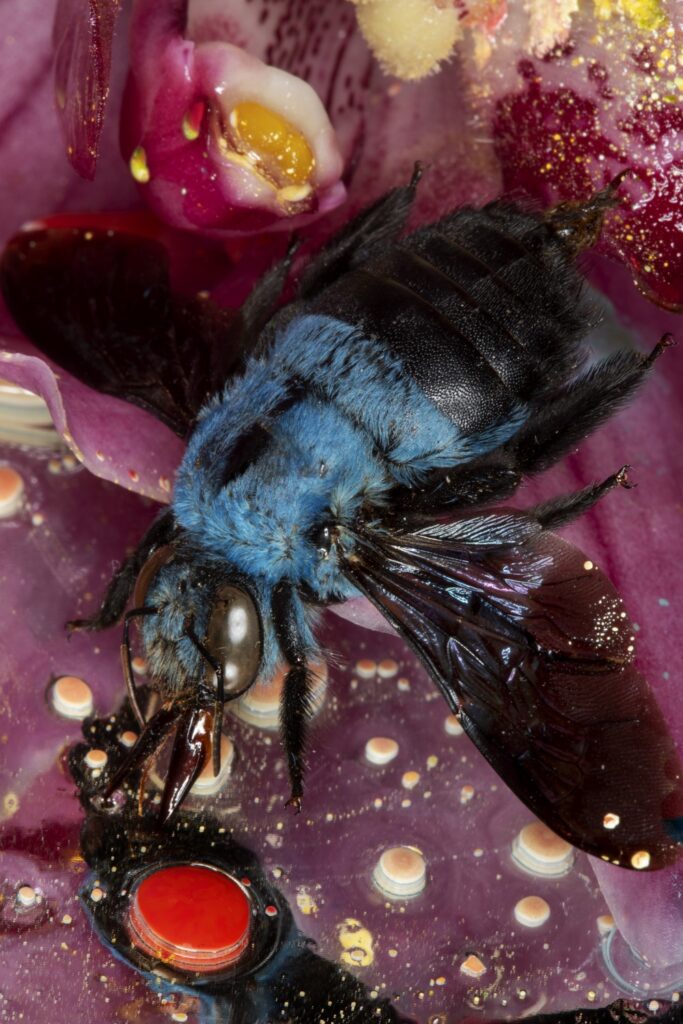
Maisie Cousins, Blue, 2020, Archival Giclée print on Hahnemuhle Pearl. © Courtesy Galería Hilario Galguera and Galería TJ Boulting.
Shelley Holcomb: Can you walk me through the concept behind the layout of your exhibition Jardín, cocina, basura y cuerpo?
Maisie Cousins: When you look back at my work, there’s some clear themes throughout and phases that naturally sort of progressed. And when we started planning the show, I thought about how so much of my work has to do with the home and like being in the home and being in my body, it felt right to have this walk through as if you were to be walking through a house or something. Each space is curated in this flow. As you enter the show, this first room is essentially the garden room where we see insects, bugs, and flowers. A lot of my subjects and my work comes from the garden and so, a lot of my early work is very floral. It’s also very sensual, and it’s very horny, to be honest with you. It’s quite funny, because when I look at it now, I’m like, “Oh, I was like in my 20s and just really horny.” [laughs] But it’s important to know where it all started. And I really feel like these two are a good starting point. [first two flower photos as you walk in] because that one’s called “blue dick” and that one’s called “bumhole”, it was playful. It was fun and I was 25. I was really just coming into myself and learning about myself and exploring my own sexuality. I feel like they’re very important in a way to start the journey of the show. I really see them as the 20s for me. You know, they’re young.
The second room is meant to be somewhat of an ode to the kitchen with all the rubbish because that’s where a lot of my imagery in here started. There’s also one dark room with a light box work “Mexico sweeties”. And I thought a lot about how the big thing when going to other countries is that wherever you go, there’s always food in a lightbox. There’s always food being paraded in front of your eyes, it doesn’t even matter where you are. You could be in a shack on the side of a road and there’s always going to be a picture of maybe delicious, maybe disgusting, pictures of food in a lightbox. And I love that human need to see a glowing image of food for us to go, “Yes, can I have some?” I love that. It’s so universal. It’s such a global thing we do everywhere. It’s so human and such basic advertising, right? And I really love that with food, the basics, back to the basics.
The last room is the most physical, both in that the imagery is really large, but that it’s all about the body. It’s kind of like, this is where it all ends up, inside the body. So, yea, it’s like a little walkthrough exploration.
S Of you…
M Yeah, basically. But I didn’t want it to be too autobiographical, because I’m not dead yet [laughs]
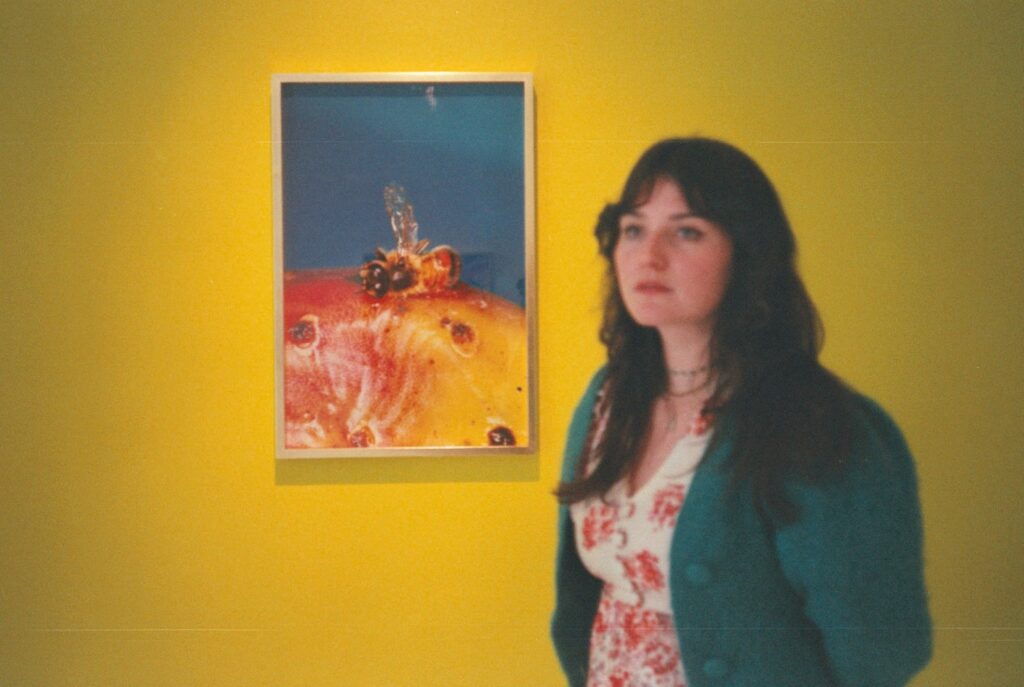
Portrait of Maisie Cousins 2021. © Courtesy of Galería Hilario Galguera.
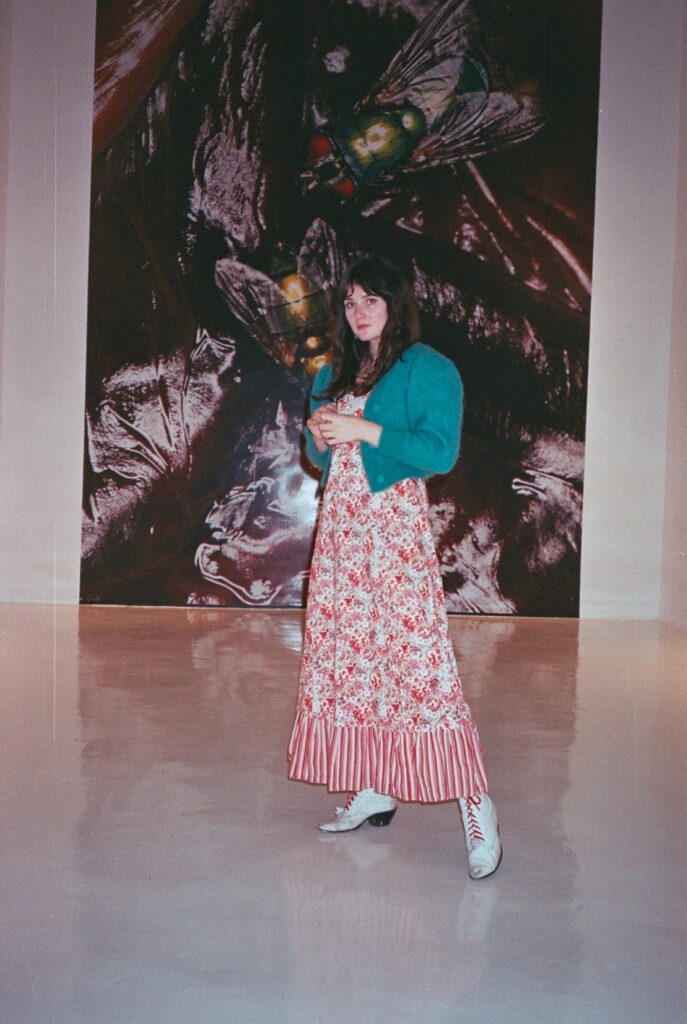
Portrait of Maisie Cousins 2021. © Courtesy of Galería Hilario Galguera.
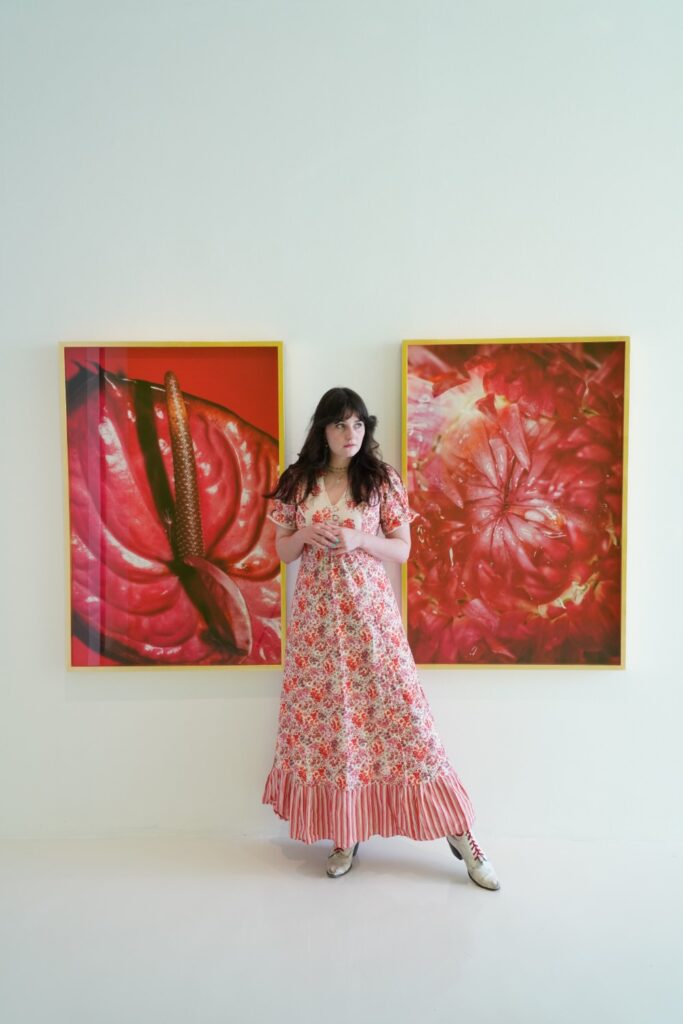
Portrait of Maisie Cousins 2021. © Courtesy of Galería Hilario Galguera.
SH: Would you say that the conception of the show was somewhat inspired by the pandemic and having to be sequestered to our homes for so long?
MC: Yeah, for sure. There’s a repetition to domestic life, which I really struggle with. I find this kind of Groundhog Day-like functioning as an adult, with a child, a family and house, it can be really hard. So, it’s kind of like an escape from that. And I can justify that because I’m like, it’s my work [laughs] which is great. It’s a way of processing how I feel, and so often I feel quite trapped in things that are regular and consistent and monotonous or minimal. All of that, to me, feels the same. It feels quite stifling.
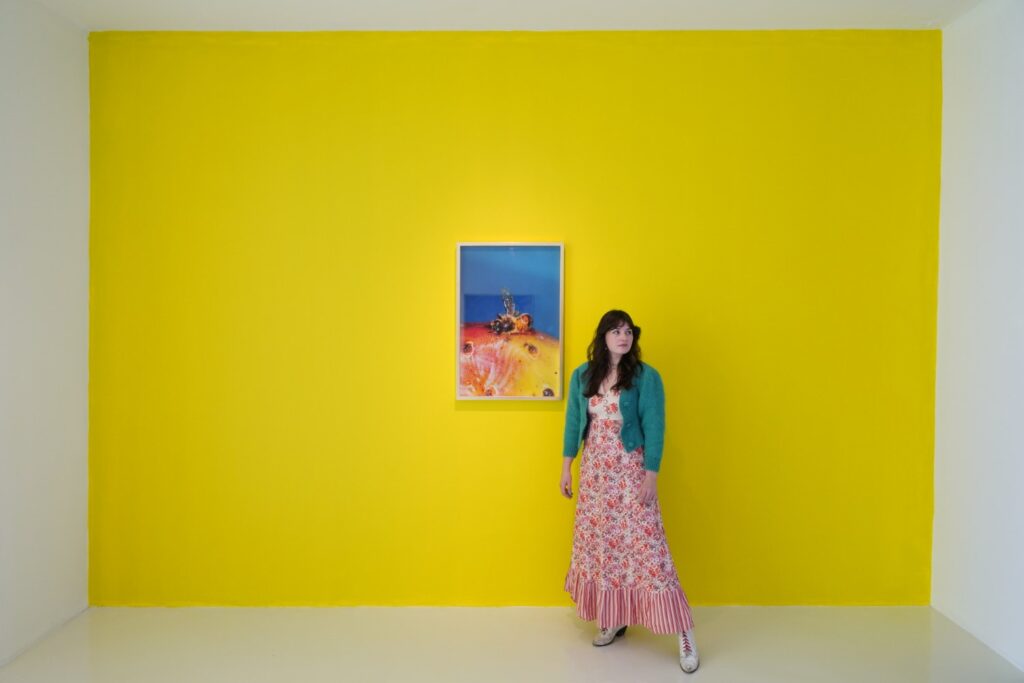
Portrait of Maisie Cousins 2021. © Courtesy of Galería Hilario Galguera.
SH: What drives you to create these works? Where does the inspiration come from?
MC: I’ve been taking pictures for a long time, it’s mainly my only form of expression, because I grew up in a small house. I wanted to do painting, but you couldn’t really do painting in a small house. So, everything was on the camera and I wouldn’t say the camera was my favorite form of material or art, but that’s the one that I could use because I didn’t have to make anything big, it was compact. So, what I like to then do is try and make these worlds that I can then blow up after. It’s like I’m trying to use the medium in a way that excites me as much as maybe playing with paint would. I approach the compositions like a shopping list, I want to put this texture and this texture, it’s a bit like cooking. You put it all together and then you just let it do its thing for a bit. Then you just go in really close with the camera and it’s like this little world.
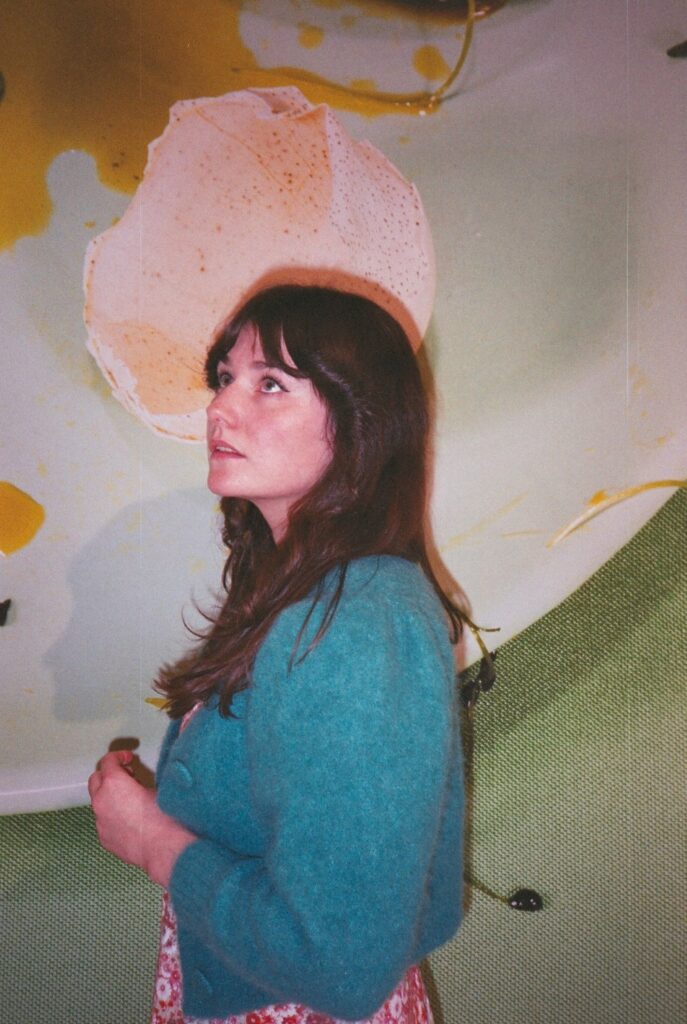
Portrait of Maisie Cousins 2021. © Courtesy of Galería Hilario Galguera.
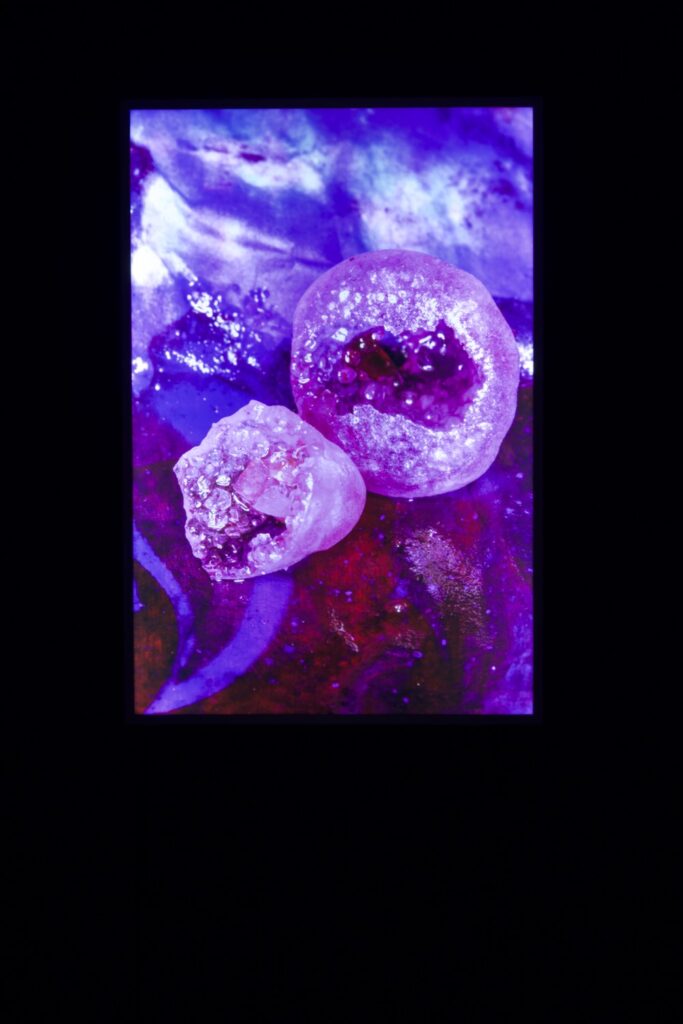
Maisie Cousins, Mexican sweeties, 2020, light box.© Courtesy Galería Hilario Galguera and Galería TJ Boulting.
SH: It’s hard to tell whether you completely set it up or if you just somehow found these combinations of objects that were in that particular state, is that on purpose?
MC: I like to draw the line between what was manipulated and what was actually found and leave it open. I think it’s more interesting for the viewer to just imagine, like to not know because then you can think about it a bit more. That’s what appeals to me, drawing that line and kind of blurring it. If it’s too manipulated by me, I’m not excited by it because it feels contrived and detached from the material. I don’t want to play God. I feel it with photography, it can be so controlling and I quite like to set things up a little bit and then let it adapt, let it decompose, let things happen, let bugs come, let it live outside for another day or two, leave it into the rain, etc, and let it run its own course.
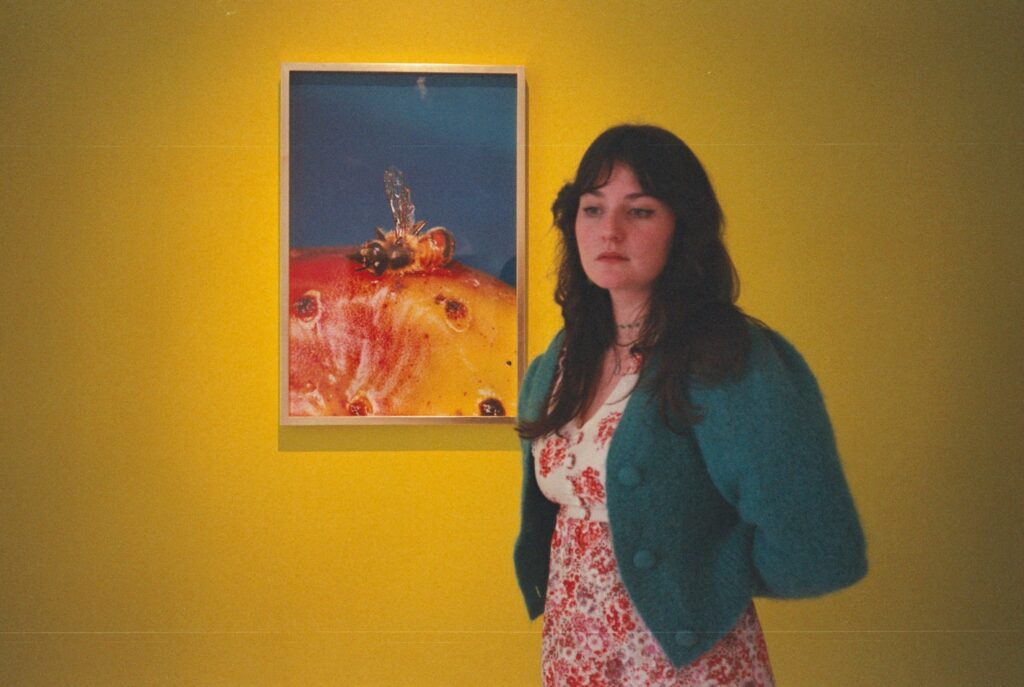
Portrait of Maisie Cousins 2021. © Courtesy of Galería Hilario Galguera.
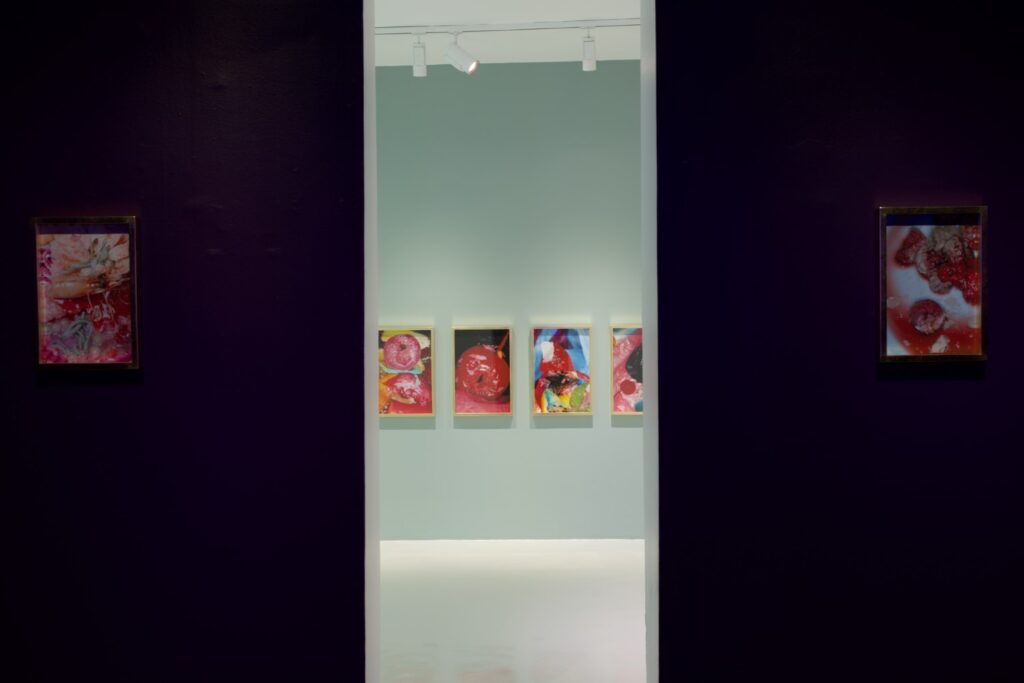
Exhibition photo Jardín, cocina, basura y cuerpo 2021. © Courtesy of Galería Hilario Galguera..
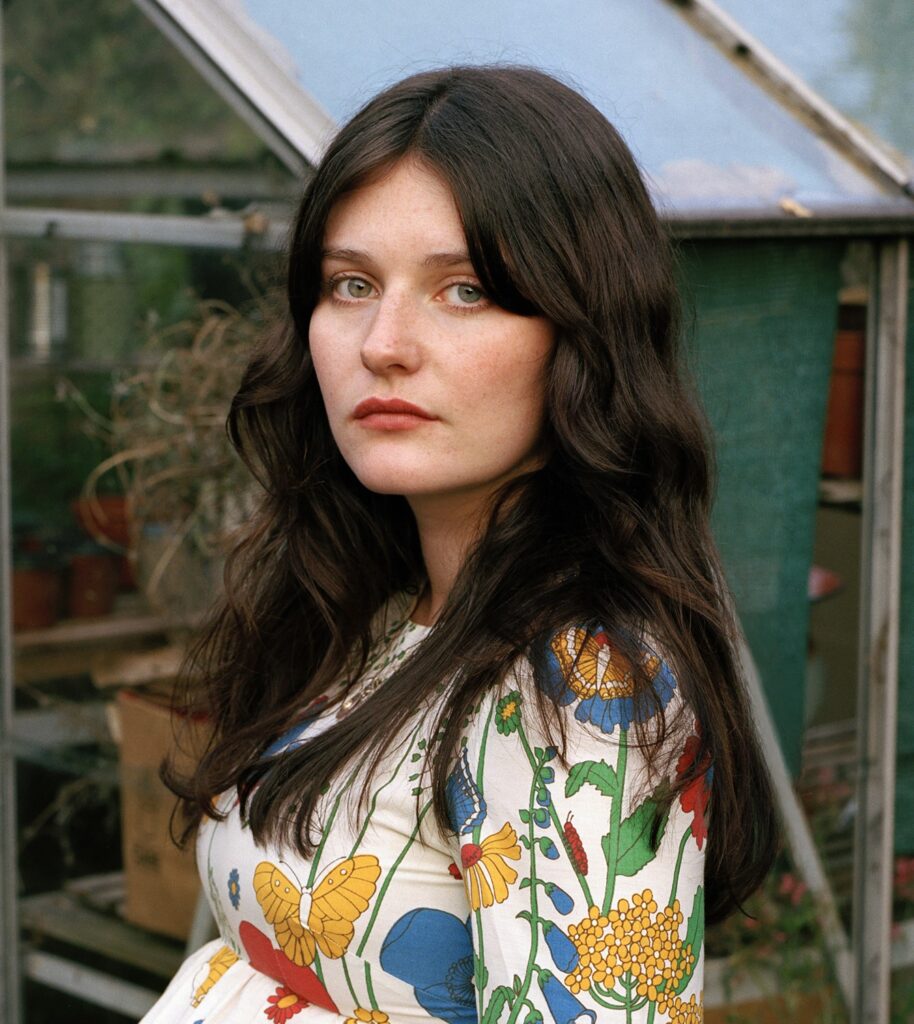
Portrait of Maisie Cousins 2021. © Tim Smyth
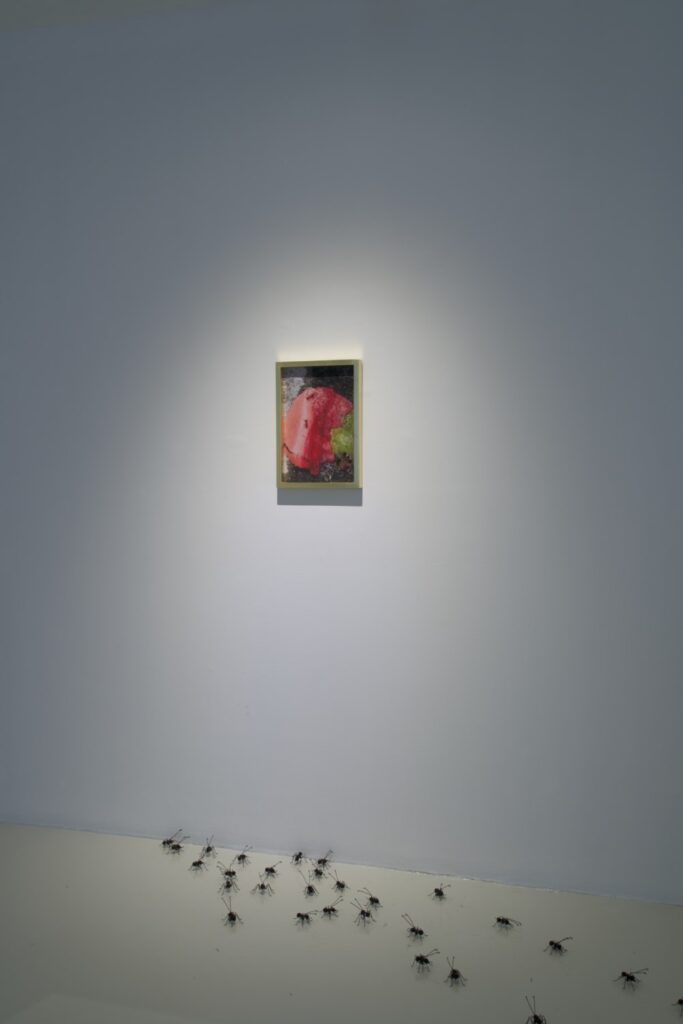
Exhibition photo Jardín, cocina, basura y cuerpo 2021. © Courtesy of Galería Hilario Galguera.
SH: I also feel like you’re very much trying to play with us as the viewer and you’re trying to push these little buttons of grotesqueness and sensualness.
MC: I think I’m just allowing a grey area for people to be in that doesn’t really exist in everyday life. I could care less if people are like, “that’s disgusting”, you know, that’s their problem. There’s this grey area that we’re not really allowed to indulge in every day, you know, it’s either like the mess you’ve got to tidy up or like the food you order when you go to eat out and you might take a picture for Instagram. But these images are this middle area of where you’ve done your cooking and the bin looks nice. Or you go to a restaurant and your wine spills into your dumplings or something and you’re like “that’s so pretty”. The rubbish on the side of the street or someone’s Chinese fell on the floor. These passing little moments. All these little things to me are so exciting and beautiful but they’re just not in our routines and not commonly noticed in our day. So, I like to give it this space, this area for people to just indulge a little bit because it is indulgent. To be able to look at a picture of rubbish for five minutes and go, that’s pretty. That’s indulgent, I think.
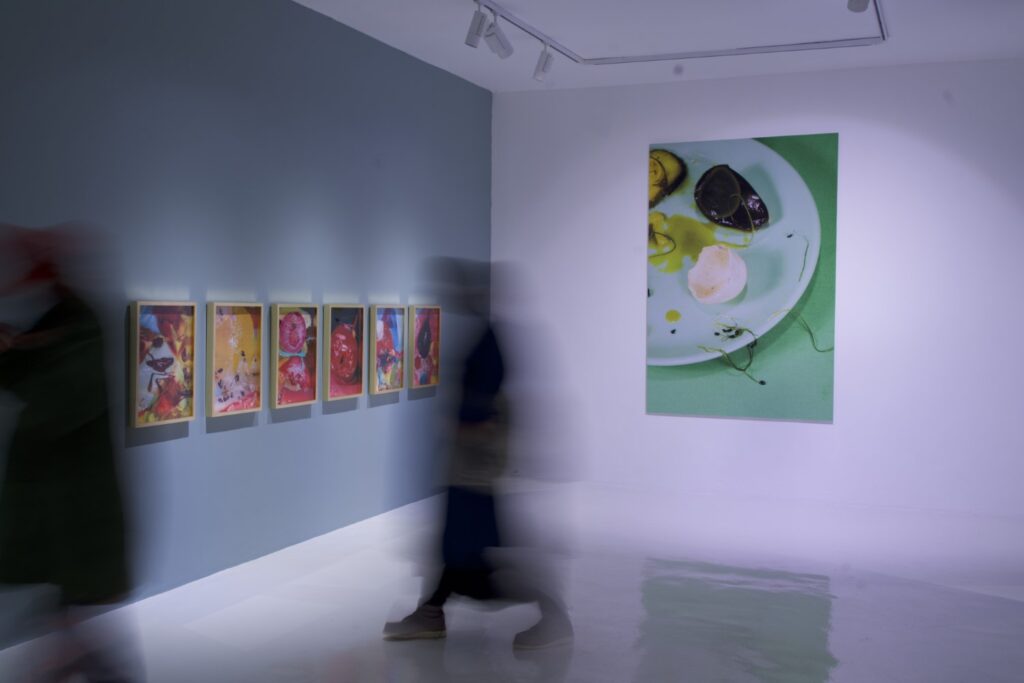
Exhibition photo Jardín, cocina, basura y cuerpo 2021. © Courtesy of Galería Hilario Galguera.
SH: What’s your relationship with the objects you choose in your still lives?
MC: It’s a variety, that’s for sure. Often, it’s a combination of what I’ve got in the fridge that’s going to be over, what I found in the market, or what looks nice in the sink whilst I’m washing up.I would say possibly that they’re pretty much everyday objects. I don’t really feel like there’s anything in them that you would find weird to find in a kitchen or a house. There’s nothing fantastical about these objects or rare.
And a lot of the time I’m just trusting in happenstance or nature for the final arrangement of the objects. I don’t ever set an intention to take a picture, I never have an image in my head because that’s part of the fun. I’d feel disappointed if I had an image in my head and then it didn’t come out. So, a lot of it is kind of leaving it to chance in nature, letting it do its thing a little bit. I don’t want to have this big photography “God” complex, which I think to myself “don’t be so serious”. I like the distance the camera can make. But also I like how close I get to these things with my camera, which I just wouldn’t normally. You can’t see this type of imagery with your eyes in real life. And that’s what’s most interesting to me, I think. I guess it’s a bit like a voyeur and just kind of a bit like collecting things as well. Like hoarding… I think there’s a big hoarding element. I’m definitely a hoarder. [laughs]
Like this image, for example, “Ants on a sweetie 2”, I found out that my neighbor had an ants’ nest in her garden, and I was like “YESSS”. [laughs] So I left some candy on the floor really close to her garden because I don’t know if she would have been okay with me going into her garden over the fence. So, I left it really, really close to her fence, but in my own yard for a day or two. You have to leave the sweet for a little bit because ants are like messengers, they go off and they come back to the group and they’re like “Um, you know there’s a big sweetie down there, come on guys.” I also wanted the rain to go on the sweetie so it would be a bit more weathered, and then I came back in the night, saw all the ants and was like, “Yes, GET IN”. It was like Christmas! It’s kind of an addiction, I would say. Like, you keep wanting more and more and more, like there’s not enough ants on that, I need to keep going. I need more.
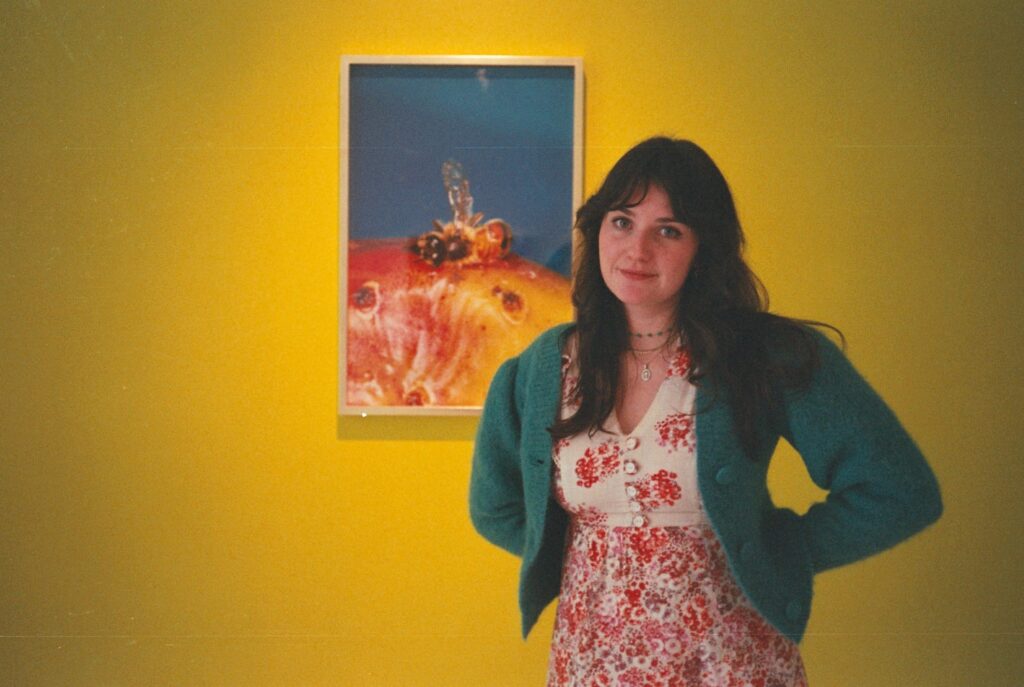
Portrait of Maisie Cousins 2021. © Courtesy of Galería Hilario Galguera.
SH: You have a series in the show, “Mercado 1-6”, prompted by your stay here. What about Mexico would you say influences your work?
MC: Yes, those are Mexico sweeties as well [points to the series of 6]. It’s kind of like a shrine to the market because it’s the things I bought from there and later made into a still life. A lot of it happened in the bag whilst walking around all day. I took it out of the bag and the fruit was all squished. [laughs] They’re a thank you to the markets here in Mexico, because they have everything I want in real life, everything I want to make pictures with. Mexico is like everything I’ve dreamed of. Everything I thought of in the studios in London and then I came here and I’m like, fuck, I don’t even have to manipulate it. I don’t even have to try and make it up to my imagination because it’s right here.
I also think there’s a huge cultural difference between Mexico and the U.K. It’s down to some very simple things as well, like, for example, people aren’t as embarrassed here. I feel there’s a kind of openness towards disgusting decay and death and I also think there’s an openness and a love for everyday art and color here. I find the UK to be quite sterile, everything is so clean looking, but it’s really not, everyone’s dirty deep down. You go on the Underground in London, you’ll probably get sick. It’s disgusting, you know, there’s like layers of the plague down there, but then everything on the top is like all clean, tidy, grey, neutral, inoffensive. I love how Mexico has the hand-painted signs, the multi-colored buildings, and that kind of lack of a need for perfection. When I come here to Mexico, everything feels more open with passion, which you have to try to find that in the UK, here you need not to try and find it, it’s everywhere.
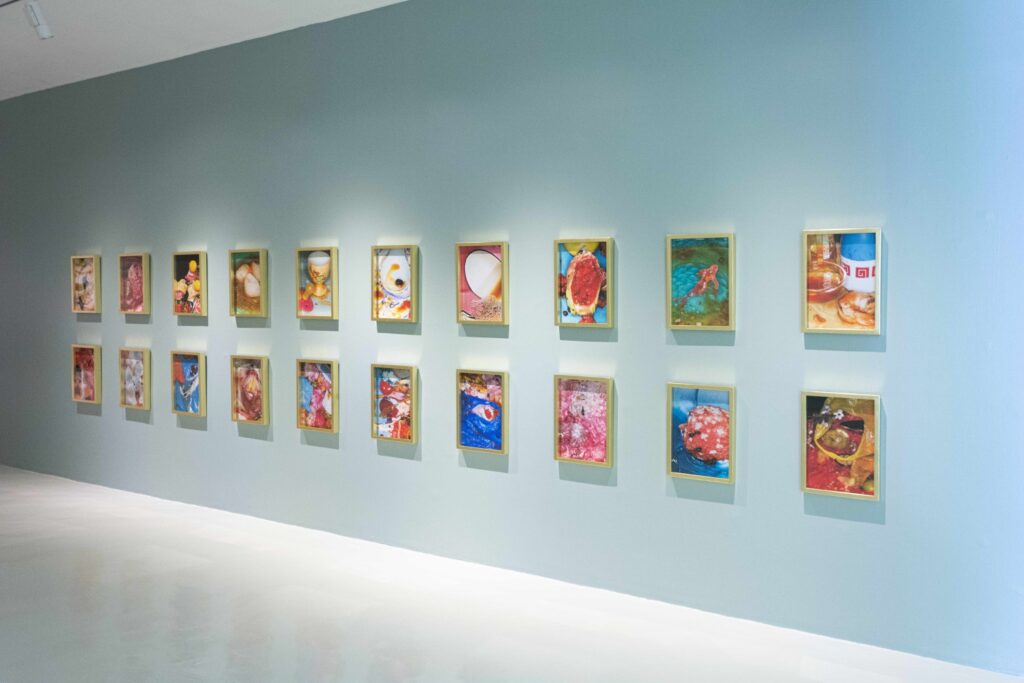
Exhibition photo Jardín, cocina, basura y cuerpoy 2021. © Courtesy of Galería Hilario Galguera.
SH: And lastly, in what direction would you say your work is going? What can we expect from you next?
MC: I just really feel like the next thing is working with the body, which requires more planning, more patience and more thoughts. So, I feel like I can’t work as impulsive as I have in the past because I want to think about it more.
I’m fascinated by everything we’ve got going on in our insides. We really kind of have no idea what’s happening inside of us at any given moment, and we don’t really want to talk about it. We’re so obsessed with our appearance on the outside, and meanwhile, we’ve got all this fucking gore going on inside and it is a mystery. It’s quite horrifying sometimes. But I’m more and more fascinated with the body and this kind of connection between household objects, things that aren’t the body that I like to use to represent it in the photos. But then also, I like to mix in the actual body as well.
Recently, I’ve found that the photos, like what’s out there [in the other galleries], don’t get me as squirmy anymore. Like I feel OK about the rubbish being exciting and I’ll probably always do it for fun, but it doesn’t get me going “errrrr” anymore. Whereas the body imagery, it really does. There’s some subconscious kind of need to get inside to know what’s going on, to be gory. It’s quite addictive.
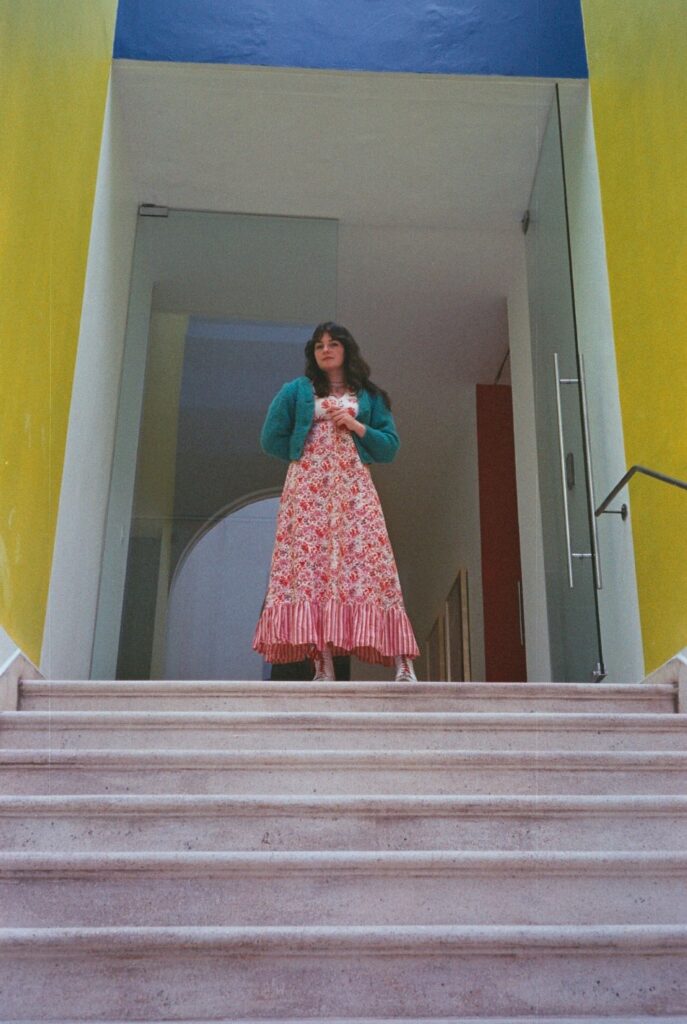
Portrait of Maisie Cousins 2021. © Courtesy of Galería Hilario Galguera.
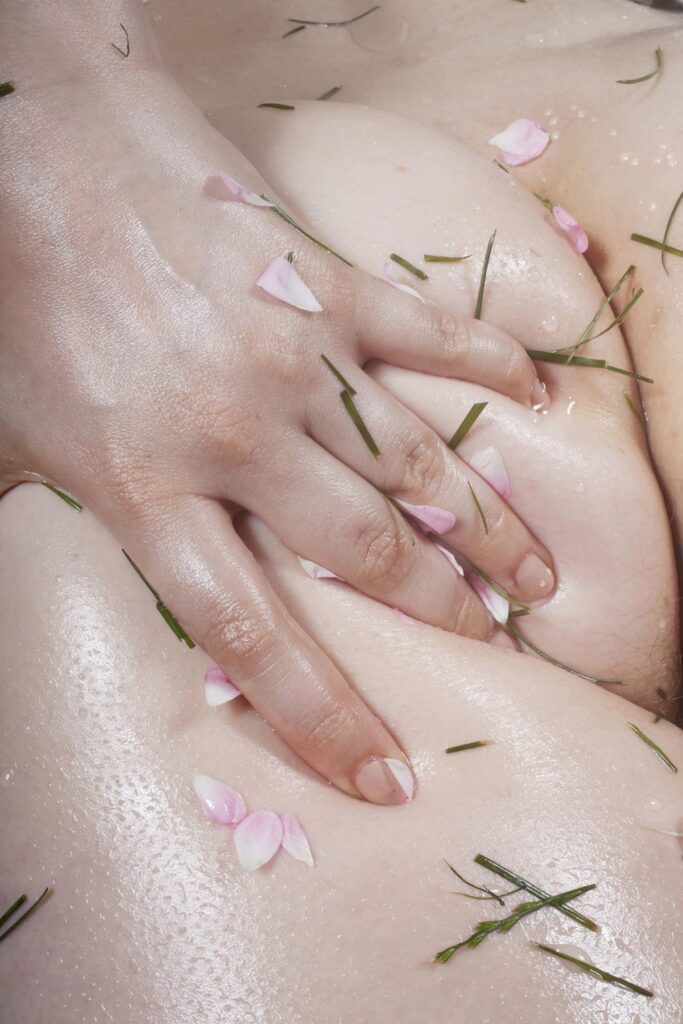
Maisie Cousins, grass bum, 2015, Archival Giclée print on Hahnemühle Pearl paper. © Courtesy of Hilario Galguera Gallery and TJ Boulting Gallery.

Portrait of Maisie Cousins 2021. © Courtesy of Galería Hilario Galguera.
Maisie Cousins (London, 1992) studied Fine Art Photography at Brighton University, completing her BA in 2014. Her first solo show ‘grass, peonie, bum’ was held in May 2017 at TJ Boulting, London. In 2018 she had the inaugural solo show at Elephant West, London, and in 2020 she had her first international solo show at Fotografiska, Stockholm, which will travel to Estonia and New York. She will have her first solo show in Mexico at Galería Hilario Galguera, Mexico City in November 2021. She has exhibited in several international group shows including at the Vogue Photo Festival in Milan, 2016, Fotofo festival, Slovakia, 2018, the European Month of Photography Luxembourg, Musée National d’Histoire et d’Art Luxembourg, 2019, the Foundation for the Exhibition of Photography, Hong Kong, 2019, the Look Photo Biennial, 2019 and the Bangkok Art Biennial 2020-21. In 2018 she completed a month-long residency in Colombia with FIBRA foundation. In 2019 she was one of FOAM Amsterdam’s FOAM Talents with a travelling exhibition to London and New York. In 2017 her work was published as part of a survey of female photographers ‘Girl on Girl’ edited by Char- lotte Jansen (Lawrence King). She has published two artist monographs with Trolley Books ‘Squeezing One Out’ in 2018 and ‘Rubbish, Dipping Sauce, Grass, peonie, bum’ in 2019, which was a finalist for the Paris Photo Aperture First Book Award and shortlisted for the Deutsche Börse Foundation Photography Prize. She is represented by TJ Boulting, London and Galería Hilario Galguera, Mexico City. She lives and works in Hastings, UK.
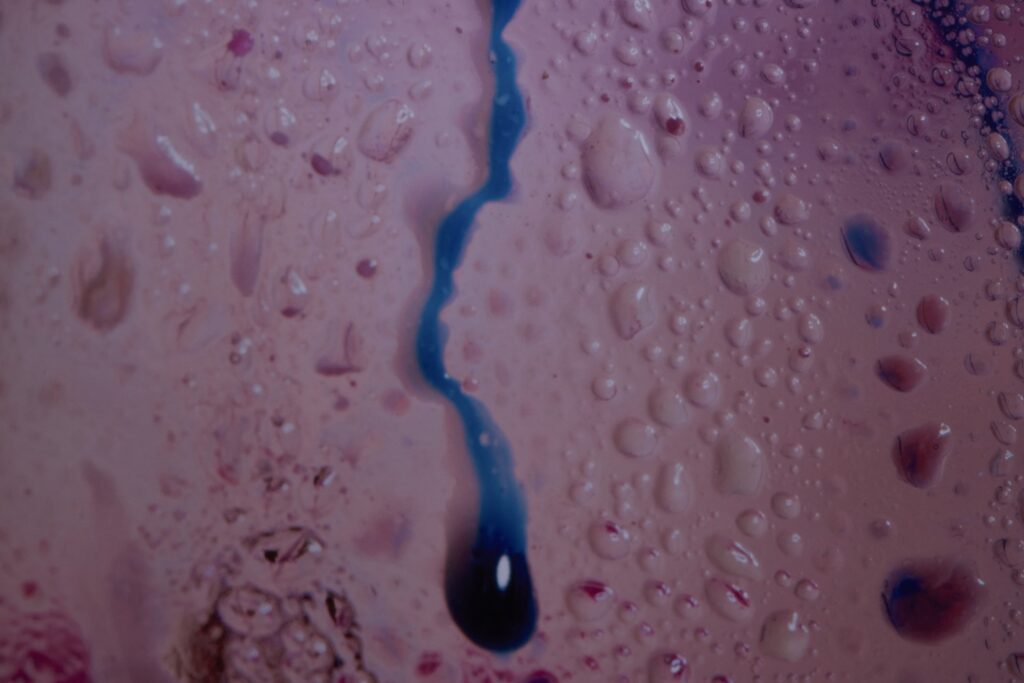
Exhibition photo Jardín, cocina, basura y cuerpo 2021. © Courtesy of Galería Hilario Galguera.
Jardín, cocina, basura y cuerpo will remain open until January 20th, 2022. https://www.galeriahilariogalguera.com
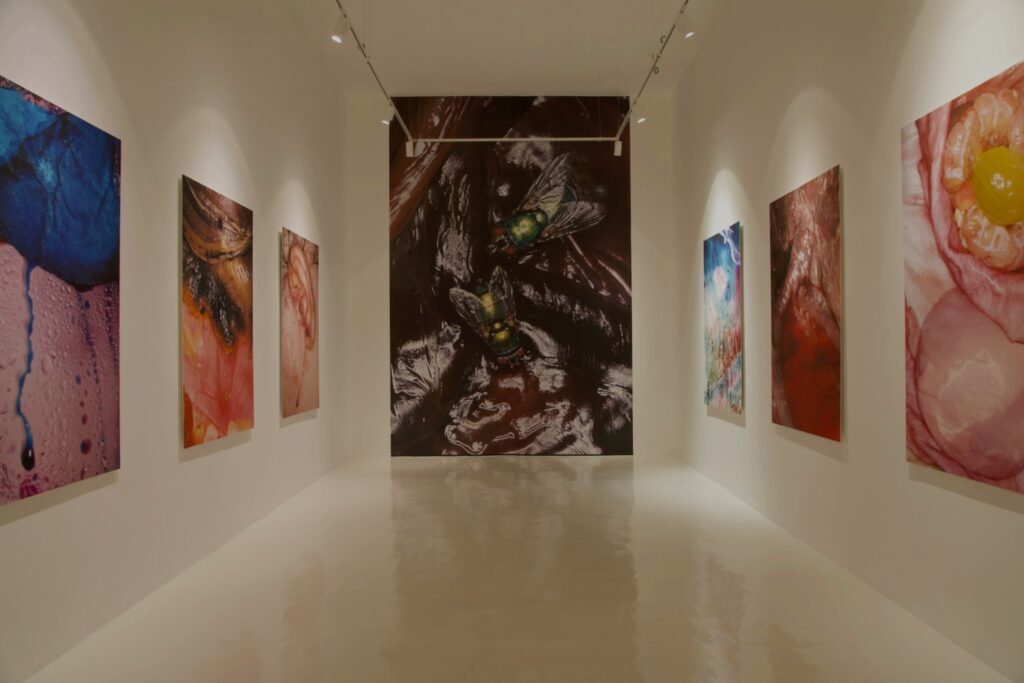
Exhibition photo Jardín, cocina, basura y cuerpo 2021. © Courtesy of Galería Hilario Galguera.
Shelley Holcomb is an artist, curator, writer, and active member of the Los Angeles and Mexico City arts communities. She is CEO and Creative Director of Curate LA and co-host of a monthly radio show on NTS, called Whits & Giggles. She holds a Painting BFA from Savannah College of Art and Design. Holcomb’s work has been exhibited in multiple institutions including the Contemporary Art Museum in Raleigh, NC, Museum of Contemporary Art in Los Angeles, CA, the Jepson Center in Savannah, GA, Attleboro Arts Museum, and Gagosian Gallery, Beverly Hills.
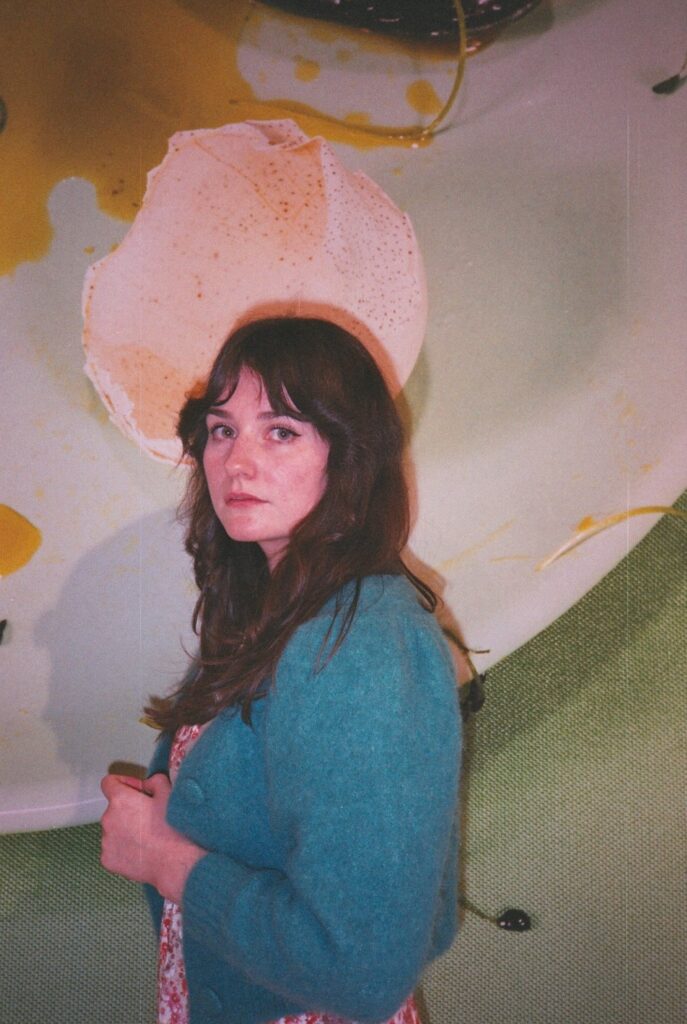
Portrait of Maisie Cousins 2021. © Courtesy of Galería Hilario Galguera.
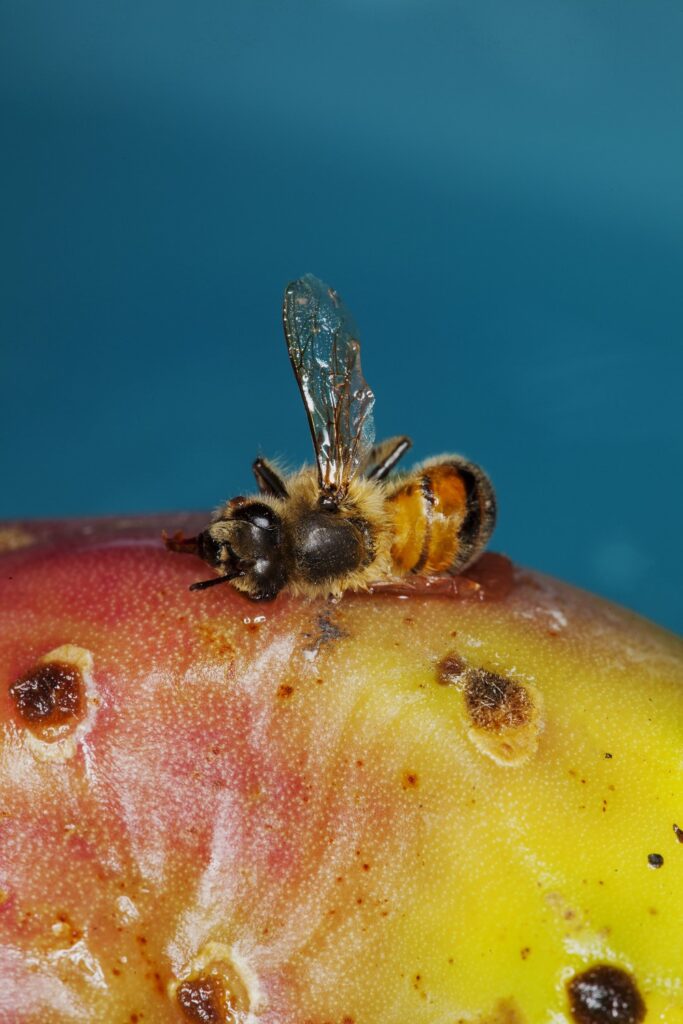
Maisie Cousins, wasp, 2017, Archival Giclée print on Hahnemuhle Pearl. © Courtesy Galería Hilario Galguera and Galería TJ Boulting.
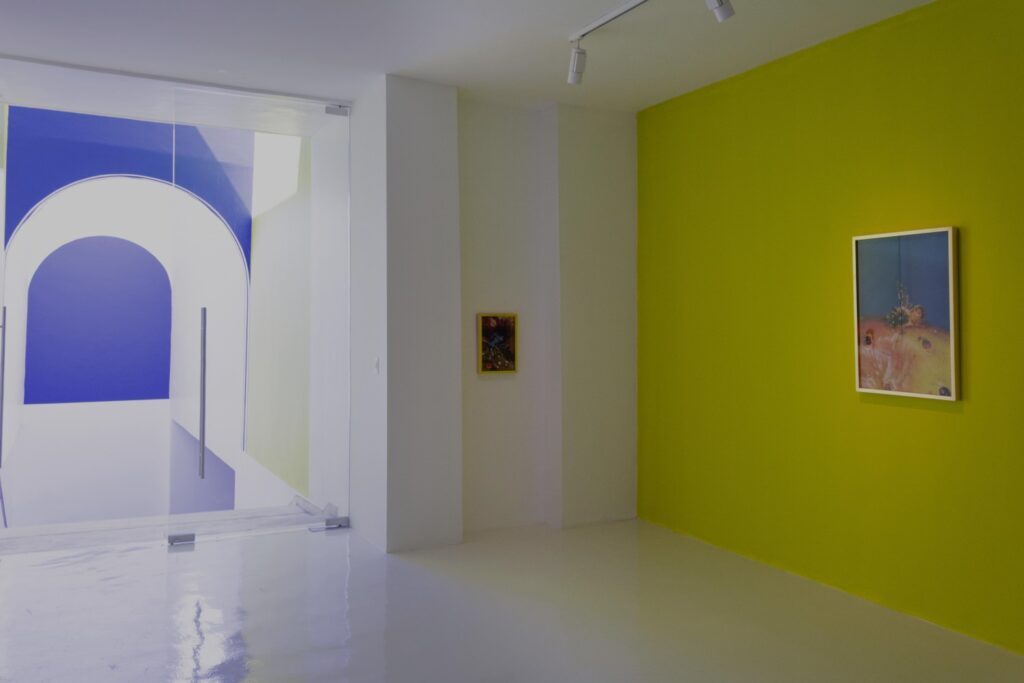
Exhibition photo Jardín, cocina, basura y cuerpo 2021. © Courtesy of Galería Hilario Galguera.